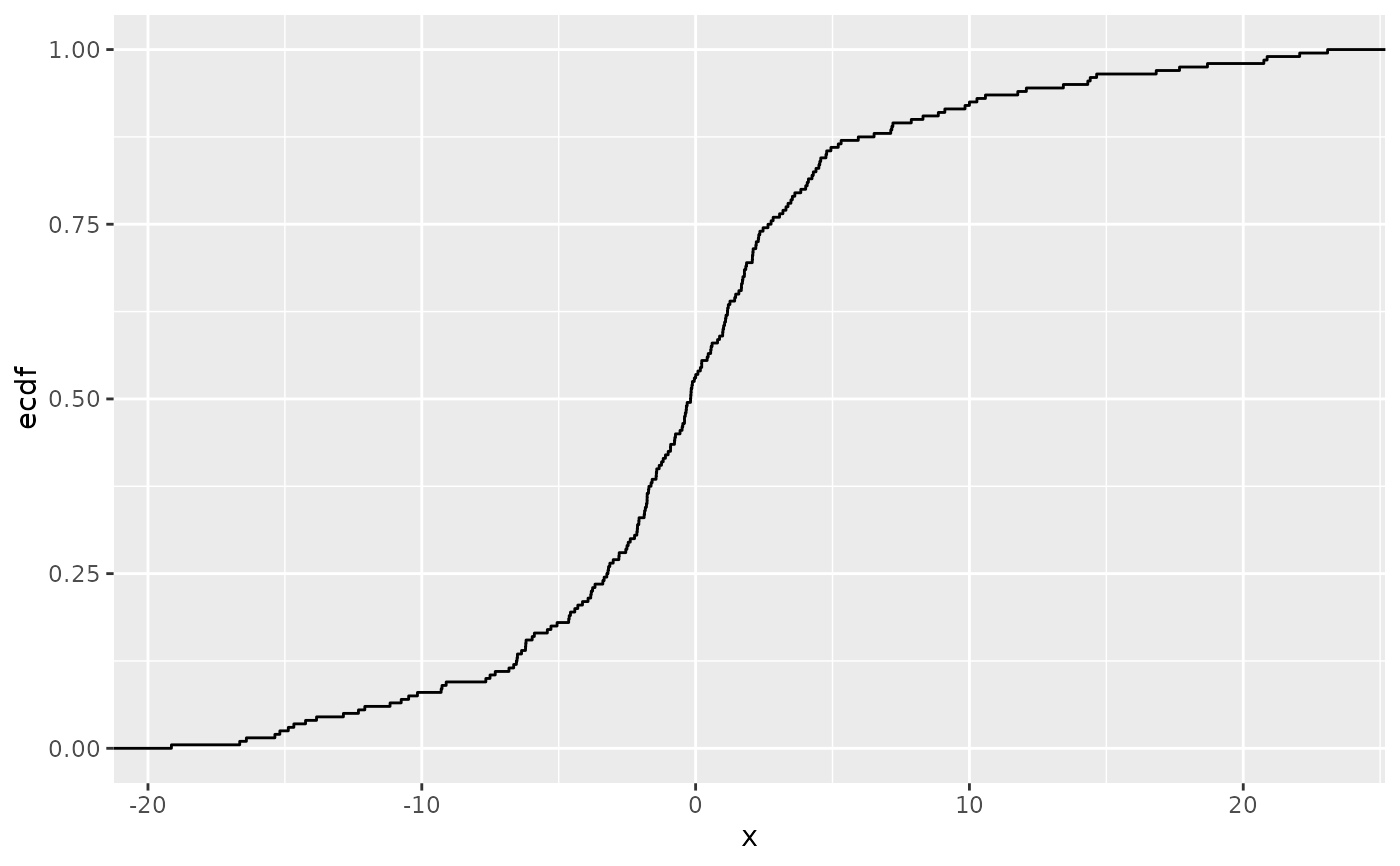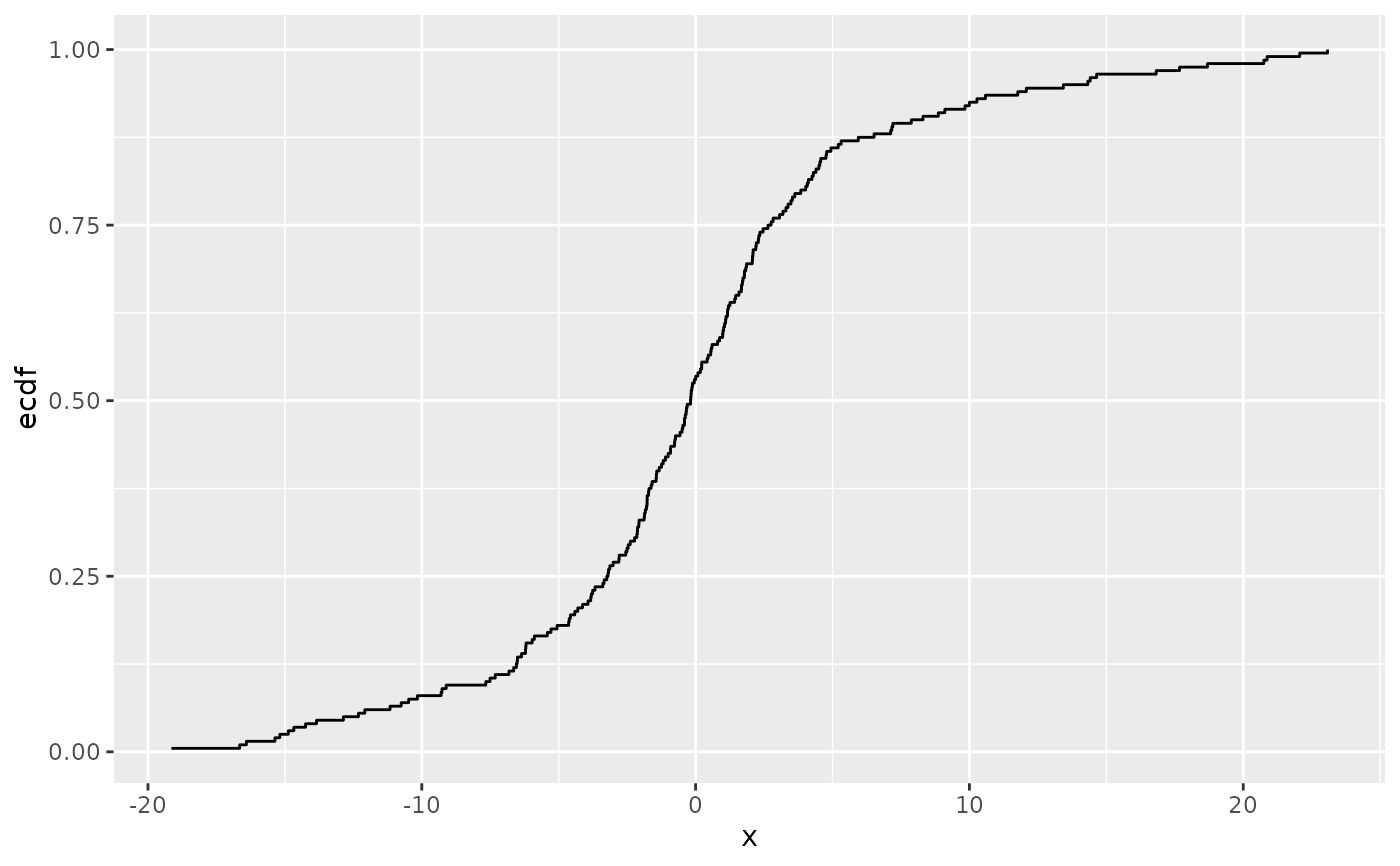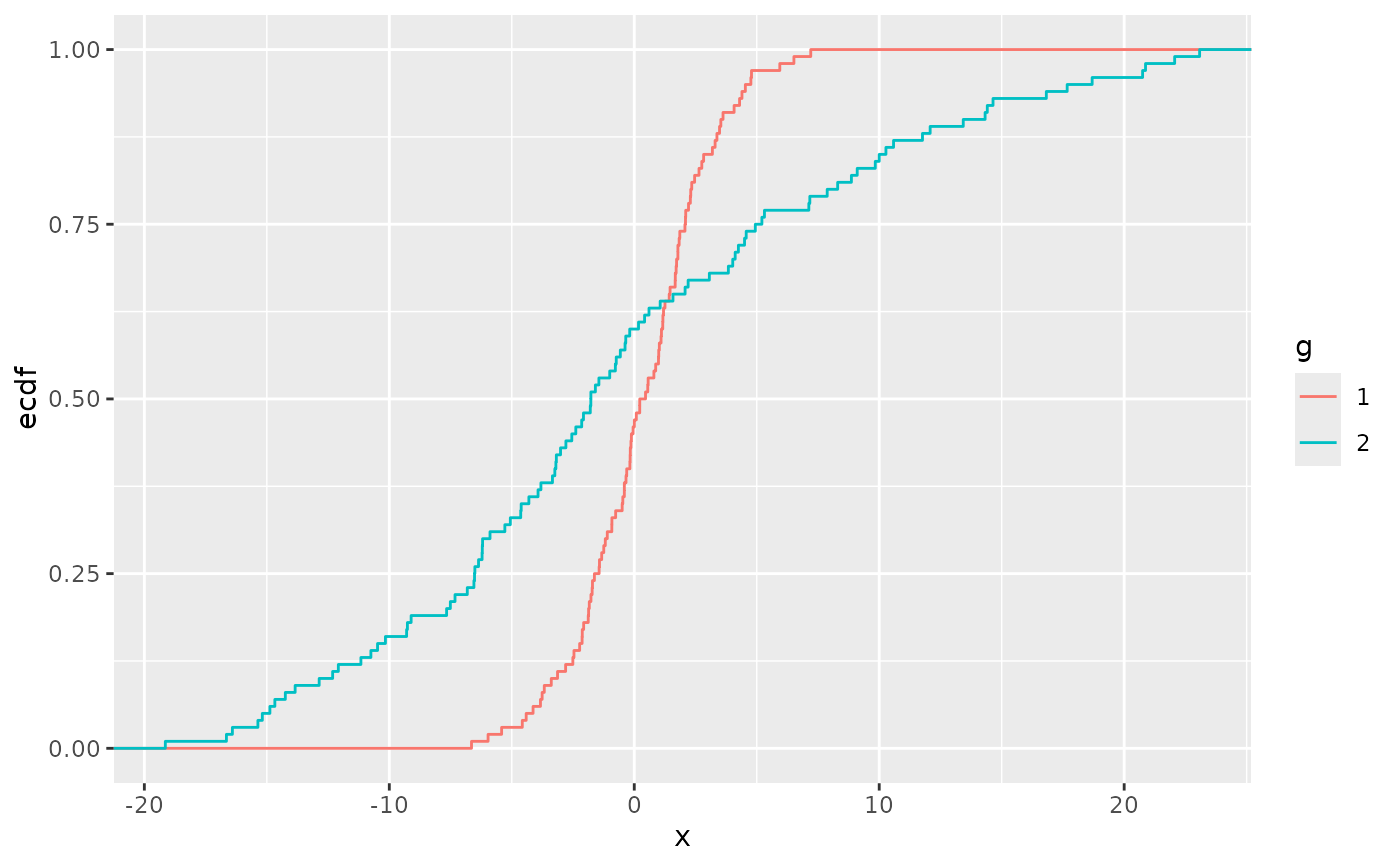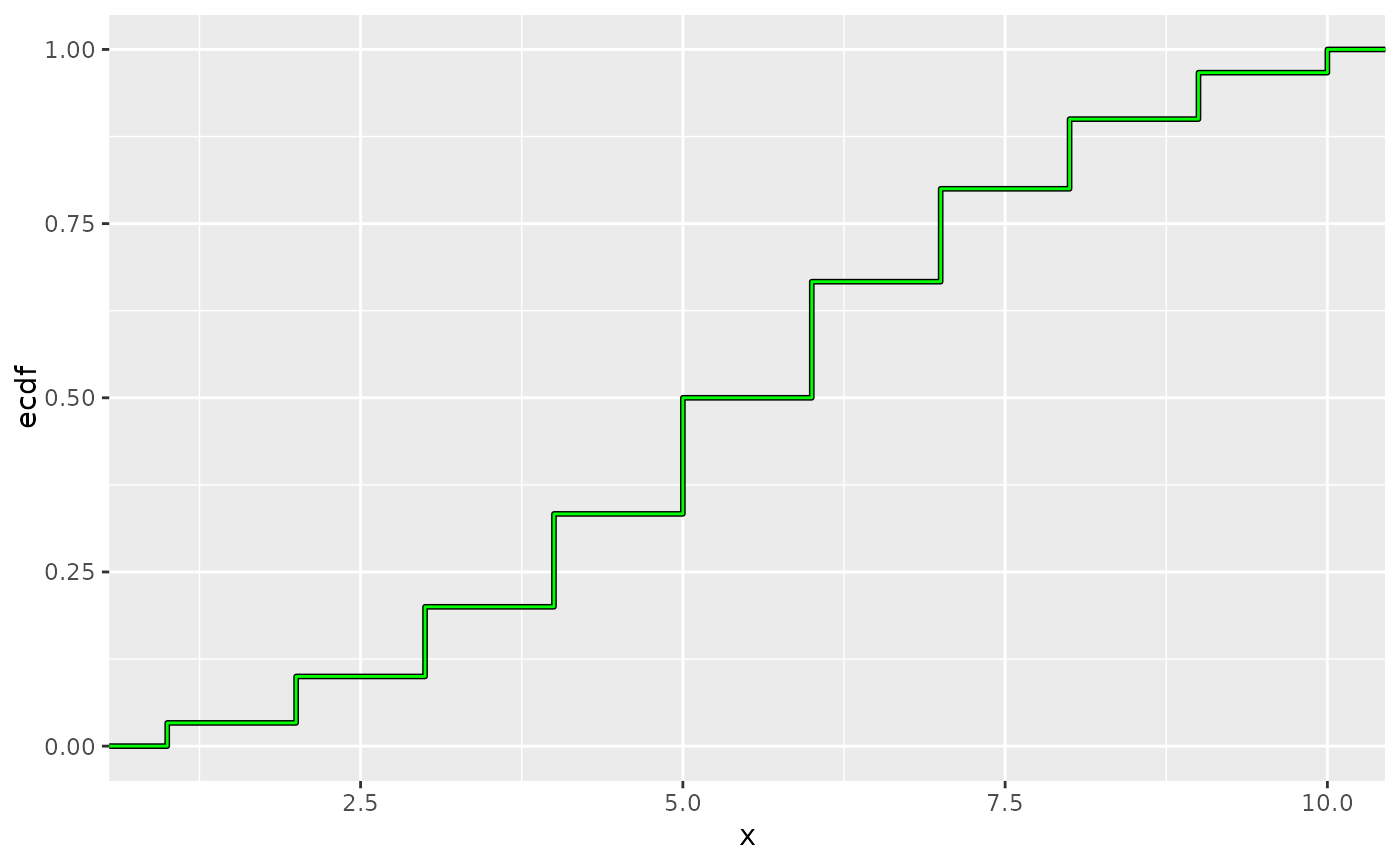The empirical cumulative distribution function (ECDF) provides an alternative
visualisation of distribution. Compared to other visualisations that rely on
density (like geom_histogram()), the ECDF doesn't require any
tuning parameters and handles both continuous and categorical variables.
The downside is that it requires more training to accurately interpret,
and the underlying visual tasks are somewhat more challenging.
Usage
stat_ecdf(
mapping = NULL,
data = NULL,
geom = "step",
position = "identity",
...,
n = NULL,
pad = TRUE,
na.rm = FALSE,
show.legend = NA,
inherit.aes = TRUE
)Arguments
- mapping
Set of aesthetic mappings created by
aes(). If specified andinherit.aes = TRUE(the default), it is combined with the default mapping at the top level of the plot. You must supplymappingif there is no plot mapping.- data
The data to be displayed in this layer. There are three options:
NULL(default): the data is inherited from the plot data as specified in the call toggplot().A
data.frame, or other object, will override the plot data. All objects will be fortified to produce a data frame. Seefortify()for which variables will be created.A
functionwill be called with a single argument, the plot data. The return value must be adata.frame, and will be used as the layer data. Afunctioncan be created from aformula(e.g.~ head(.x, 10)).
- geom
The geometric object to use to display the data for this layer. When using a
stat_*()function to construct a layer, thegeomargument can be used to override the default coupling between stats and geoms. Thegeomargument accepts the following:A
Geomggproto subclass, for exampleGeomPoint.A string naming the geom. To give the geom as a string, strip the function name of the
geom_prefix. For example, to usegeom_point(), give the geom as"point".For more information and other ways to specify the geom, see the layer geom documentation.
- position
A position adjustment to use on the data for this layer. This can be used in various ways, including to prevent overplotting and improving the display. The
positionargument accepts the following:The result of calling a position function, such as
position_jitter(). This method allows for passing extra arguments to the position.A string naming the position adjustment. To give the position as a string, strip the function name of the
position_prefix. For example, to useposition_jitter(), give the position as"jitter".For more information and other ways to specify the position, see the layer position documentation.
- ...
Other arguments passed on to
layer()'sparamsargument. These arguments broadly fall into one of 4 categories below. Notably, further arguments to thepositionargument, or aesthetics that are required can not be passed through.... Unknown arguments that are not part of the 4 categories below are ignored.Static aesthetics that are not mapped to a scale, but are at a fixed value and apply to the layer as a whole. For example,
colour = "red"orlinewidth = 3. The geom's documentation has an Aesthetics section that lists the available options. The 'required' aesthetics cannot be passed on to theparams. Please note that while passing unmapped aesthetics as vectors is technically possible, the order and required length is not guaranteed to be parallel to the input data.When constructing a layer using a
stat_*()function, the...argument can be used to pass on parameters to thegeompart of the layer. An example of this isstat_density(geom = "area", outline.type = "both"). The geom's documentation lists which parameters it can accept.Inversely, when constructing a layer using a
geom_*()function, the...argument can be used to pass on parameters to thestatpart of the layer. An example of this isgeom_area(stat = "density", adjust = 0.5). The stat's documentation lists which parameters it can accept.The
key_glyphargument oflayer()may also be passed on through.... This can be one of the functions described as key glyphs, to change the display of the layer in the legend.
- n
if NULL, do not interpolate. If not NULL, this is the number of points to interpolate with.
- pad
If
TRUE, pad the ecdf with additional points (-Inf, 0) and (Inf, 1)- na.rm
If
FALSE(the default), removes missing values with a warning. IfTRUEsilently removes missing values.- show.legend
Logical. Should this layer be included in the legends?
NA, the default, includes if any aesthetics are mapped.FALSEnever includes, andTRUEalways includes. It can also be a named logical vector to finely select the aesthetics to display. To include legend keys for all levels, even when no data exists, useTRUE. IfNA, all levels are shown in legend, but unobserved levels are omitted.- inherit.aes
If
FALSE, overrides the default aesthetics, rather than combining with them. This is most useful for helper functions that define both data and aesthetics and shouldn't inherit behaviour from the default plot specification, e.g.annotation_borders().
Details
The statistic relies on the aesthetics assignment to guess which variable to use as the input and which to use as the output. Either x or y must be provided and one of them must be unused. The ECDF will be calculated on the given aesthetic and will be output on the unused one.
If the weight aesthetic is provided, a weighted ECDF will be computed. In
this case, the ECDF is incremented by weight / sum(weight) instead of
1 / length(x) for each observation.
Computed variables
These are calculated by the 'stat' part of layers and can be accessed with delayed evaluation.
Dropped variables
- weight
After calculation, weights of individual observations (if supplied), are no longer available.
Aesthetics
stat_ecdf() understands the following aesthetics. Required aesthetics are displayed in bold and defaults are displayed for optional aesthetics:
| • | x or y | |
| • | group | → inferred |
| • | weight | → NULL |
Learn more about setting these aesthetics in vignette("ggplot2-specs").
Examples
set.seed(1)
df <- data.frame(
x = c(rnorm(100, 0, 3), rnorm(100, 0, 10)),
g = gl(2, 100)
)
ggplot(df, aes(x)) +
stat_ecdf(geom = "step")
 # Don't go to positive/negative infinity
ggplot(df, aes(x)) +
stat_ecdf(geom = "step", pad = FALSE)
# Don't go to positive/negative infinity
ggplot(df, aes(x)) +
stat_ecdf(geom = "step", pad = FALSE)
 # Multiple ECDFs
ggplot(df, aes(x, colour = g)) +
stat_ecdf()
# Multiple ECDFs
ggplot(df, aes(x, colour = g)) +
stat_ecdf()
 # Using weighted eCDF
weighted <- data.frame(x = 1:10, weights = c(1:5, 5:1))
plain <- data.frame(x = rep(weighted$x, weighted$weights))
ggplot(plain, aes(x)) +
stat_ecdf(linewidth = 1) +
stat_ecdf(
aes(weight = weights),
data = weighted, colour = "green"
)
# Using weighted eCDF
weighted <- data.frame(x = 1:10, weights = c(1:5, 5:1))
plain <- data.frame(x = rep(weighted$x, weighted$weights))
ggplot(plain, aes(x)) +
stat_ecdf(linewidth = 1) +
stat_ecdf(
aes(weight = weights),
data = weighted, colour = "green"
)

